Rapid Determination of 24 Synthetic and Natural Cannabinoids for LC–MS-MS Screening in Natural Products and Drug Inspection Applications
Special Issues
Marijuana, the common or slang term for cannabis in its herbal form, is one of the most widely used illicit drugs in the world.
Marijuana, the common or slang term for cannabis in its herbal form, is one of the most widely used illicit drugs in the world. Synthetic cannabinoids have similar psychotropic effects to the natural ones and are rapidly being integrated by the illicit market. To deal with their expanding number and diversity, a targeted and untargeted liquid chromatography–tandem mass spectrometry (LC–MS-MS) screening method was developed, allowing for the simultaneous analysis of 24 synthetic and natural cannabinoids in 8 min for a wide variety of samples such as herbal smoking mixtures, incense sticks, serums, and cannabis plant material. The particular advantage of this LC–MS-MS method is that the full scan event in the MS acquisition provides accurate masses for all detected species and thus allows postanalysis identification of initially untargeted compounds.
The primary psychoactive compound in cannabis is Δ9-tetrahydrocannabinol (THC), which exerts its activity by interacting with the CB1 and CB2 cannabinoid receptors in the brain. Synthetic analogs of THC, when smoked or orally ingested, can mimic the psychotropic effects of cannabis by binding the same receptors (1). Cannabimimetic compounds can be found in herbal mixtures (incense stick, cigarette, Spice, K2), serums, and other matrices, often with no indication of their presence. The European monitoring center for drugs and drug addiction reported in 2009 (2) that spice products (3) were generally used by teenagers and young adults because it enabled them to pass drug-screening tests. Many governments have taken legal action to control specific synthetic cannabinoids. In the United States, they have been listed as Schedule I drugs on the Controlled Substances Act, and in Canada as Schedule II drugs. However, small structural modifications from the controlled substance result in new analogs being legal. Therefore, in May 2012 the United States amended the Act and proposed a bill to place all cannabimimetic agents as Schedule I drugs (4,5).
Given the structural similarities between THC and its synthetic analogs, identification of the compounds in seized samples is a continuous challenge for government agencies. As quickly as analogs are added to controlled substance lists, new ones are synthesized, making their monitoring a moving target (6–9). These new generation analogs are obviously not present in mass spectrometry (MS) or UV spectra libraries; therefore, routine methods for screening cannabimimetics in both products and biofluids rapidly become less effective.
The most common methods of cannabinoid analysis use gas chromatography (GC)–MS (10,11) and liquid chromatography (LC)–MS (9,12–14). GC–MS approaches use MS spectra of known cannabinoids for identification, and most LC–MS approaches are used in multiple reaction monitoring (MRM) mode. Both are targeted methods that are limited to screening known species and are therefore always one step behind in the monitoring of this dynamic designer drug market. To address this shortcoming, we report a targeted–untargeted high-resolution MS approach to screen a variety of samples for cannabinoid-like compounds. The current method includes a high-resolution, nontarget scan that allows identification of all species if present in the sample and targets a selection of 20 synthetic and four natural cannabinoids (Figure 1).
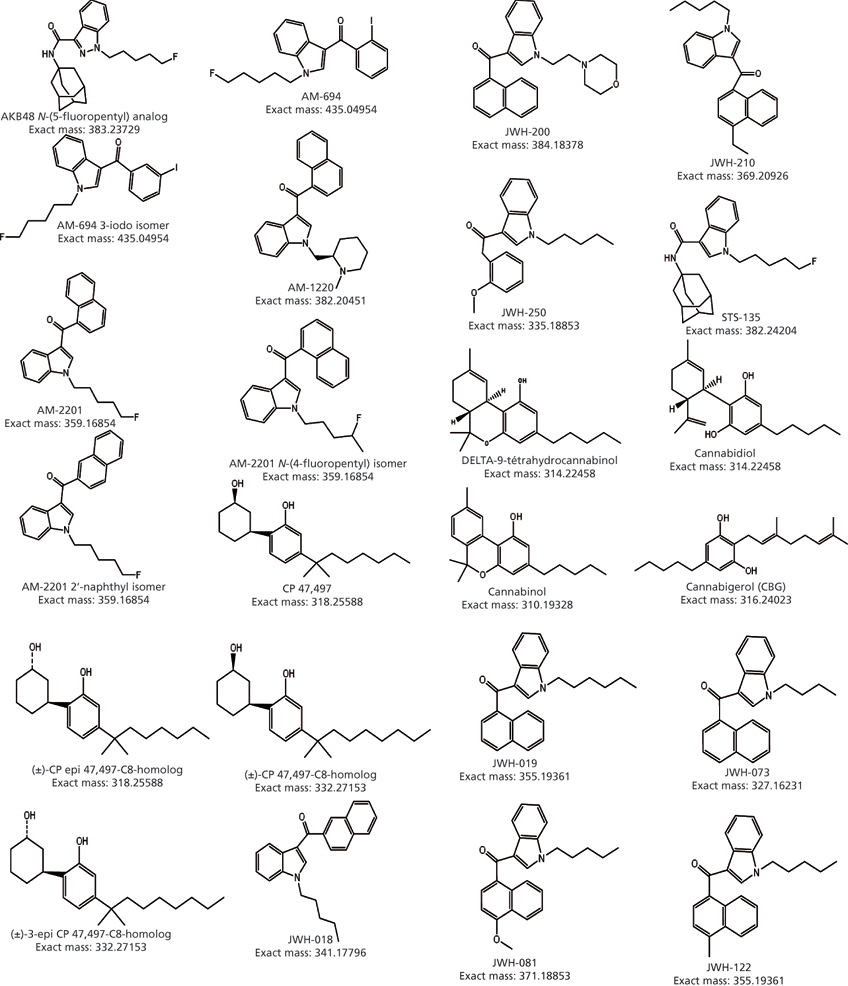
Figure 1: Chemical structures and accurate masses of the 24 synthetic and natural cannabinoids investigated.
Experimental
Reagents and Standards
LC–MS-grade methanol and acetonitrile were from J.T. Baker (TekniScience) and LC–MS-grade formic acid (98%) was from Fluka (Sigma-Aldrich). High performance liquid chromatography (HPLC)-grade water from a Milli-Q Reference A+ system (Fisher Scientific) was used to prepare all aqueous solutions and mobile phases.
A total of 24 standards were investigated. JWH-018 and JWH-210 were obtained from Toronto Research Chemicals Inc. AKB48 N-(5-fluoropentyl) analog, AM-694, AM-694 3-iodo isomer, AM-1220, AM-2201, AM-2201 2'-naphthyl isomer, AM-2201 N-(4-fluoropentyl) isomer, CP 47,497, (±)-CP 47,497-C8-homolog, (±)-epi CP 47,497-C8-homolog, (±) 3-epi CP 47,497-C8-homolog, JWH-019, JWH-073, JWH-081, JWH-122, JWH-200, JWH-250, and STS-135 were obtained from Cayman Chemical. Δ9-Tetrahydrocannabinol and cannabinol were purchased from Alltech/Grace. Cannabidiol was purchased from Lipomed and cannabigerol was purchased from THC PHARM.
Stock solutions of individual standards were prepared separately in 10-mL volumetric flasks at an approximate concentration of 100 μg/mL in methanol. Diluted stock solutions (100 ng/mL to 1 μg/mL) were directly infused into the mass spectrometer for adjustment of the experimental parameters for each analyte. A standard mixture of the 24 components was also prepared and injected to adjust the chromatographic separation of all analogs.
Sample Preparation
To determine the effectiveness and robustness of the LC–MS-MS method, 10 seized samples and a cannabis sample were analyzed. The samples were present in two forms: tablets and herbal products (incense stick, cigarette, and a cannabis plant). They were finely ground, then aliquots of 5–10 mg of the resulting powder were transferred to 10-mL volumetric flasks and dissolved in 70:20:10 methanol–water–acetonitrile containing 1% formic acid. Following this, the solutions were vortexed for 2 min, sonicated for 10 min, and vortexed again for 3 min. The supernatant was filtered through a 0.45-μm pore polytetrafluoroethylene (PTFE) syringe filter (Phenomenex). Herbal samples required an additional centrifugation step at 3500 rpm for 10 min to avoid mass overloading of the syringe filter. Filtrates were diluted 10–100-fold in 80:20 water–acetonitrile, the initial mobile phase, before injection.
LC–MS-MS Operating Conditions
Data were acquired on an LTQ Orbitrap XL mass spectrometer coupled to an Acella HPLC system (Thermo Scientific). Xcalibur 2.1 and Thermo LTQ Tune Plus 2.5.5 software (Thermo Scientific) were used to control the system and process the data. External mass calibration was used throughout the project. Four analytical columns were initially tested for their chromatographic performance: 100 mm × 2.1 mm, 3.5-μm dp XTerra C18 and 100 mm × 2.1 mm, 1.7-μm dp Acquity BEH C18 columns, both from Waters; a 75 mm × 2.1 mm, 2.6-μm dp Kinetex C18 column from Phenomenex; and a 100 mm × 2.1 mm, 2.6-μm dp Accucore aQ C18 column from Thermo Scientific. Two eluent systems were tested during method development, water–methanol and water–acetonitrile, both containing 0.1% formic acid, under generic gradient conditions (5–95% organic).
Optimized separations were carried out using the Accucore aQ column coupled to a 4 mm × 2.0 mm Phenomenex C18 guard column, both maintained at 40 °C, and the water–acetonitrile gradient. The autosampler temperature was set at 10 °C to avoid sample degradation. Eluents consisted of 0.1% formic acid in water (eluent A) and 0.1% formic acid in acetonitrile (eluent B), and the initial mobile phase contained 20% B. The following gradient elution was applied at a flow rate of 350 μL/min: 20–58% B over 1 min, held at 58% B for 1 min, increased to 85% B over 1 min, then held at 85% B for 2 min. Eluent B was then returned to 20% B over 0.2 min. The system was allowed to reequilibrate for 2.8 min, giving a total cycle time of 8.0 min. The injection volume was 3–5 μL. A needle wash step using 70:20:10 methanol–water–acetonitrile was included in the method. A 5-μL blank, consisting of the initial mobile phase, was injected after each sample to monitor and reduce any potential carryover.
The electrospray interface was operated in positive ion mode. Nitrogen was used as both sheath gas and auxiliary gas while helium was used as collision gas. Using direct infusion, instrumental parameters were adjusted semiautomatically for every analyte using the tune tool in the LTQ Tune Plus software. The parent ions of all analytes showed similar behavior due to their similar structures. After screening every compound individually, the experimental parameters of the full scan event that were found to be suitable for all analytes were set to the following values: sheath and auxiliary gas at flow rates of 44 and 17 (instrument units), respectively; spray voltage, +3500 V; capillary temperature, 310 °C; capillary voltage, 28 V; tube lens, 101. The MS2 and MS3 transitions for every compound were also determined using the tune tool by varying the normalized collision energy. They ranged between 25% and 33% after they were optimized. Therefore, a three-step collision energy function set at 25%, 30%, and 35% was used to perform average fragmentation on every compound. The ion transitions MS2 and MS3 for each standard are shown in Table I, where the MS3 transitions arise from the MS2 value shown in boldface type. Mass spectra were acquired from m/z 50 to 1000 using two scan events: the first was a Fourier transform (FT)-MS full scan for accurate mass detection and the second was a data dependent step with MS-MS acquired only for precursors from the parent mass list with a dynamic exclusion of 10 s. Every standard was then injected onto the column individually to determine its retention time and confirm the parent ion accurate mass, MS2 and MS3. To determine if there were any interactions between the compounds, a mixture of the 24 standards was injected.

Results and Discussion
Method Development and Validation
As seen in Figure 1, many of the 24 compounds have similar structures, which makes the chromatographic separation challenging. Between the mobile phases tested, the acetonitrile gradient gave better selectivity. Between the columns tested, the Accucore aQ gave the best selectivity and retention of early eluted analytes.
Selectivity was further enhanced by coupling the optimized chromatographic method to the high-mass-resolution orbital ion trap mass spectrometer. By individual direct infusion of the standards, the final optimized parameters for full-scan detection (values presented in the LC–MS-MS operating conditions section) were selected to provide appropriate sensitivity for all 24 components in a single analysis. The mass accuracy across the whole study was within 3 ppm.
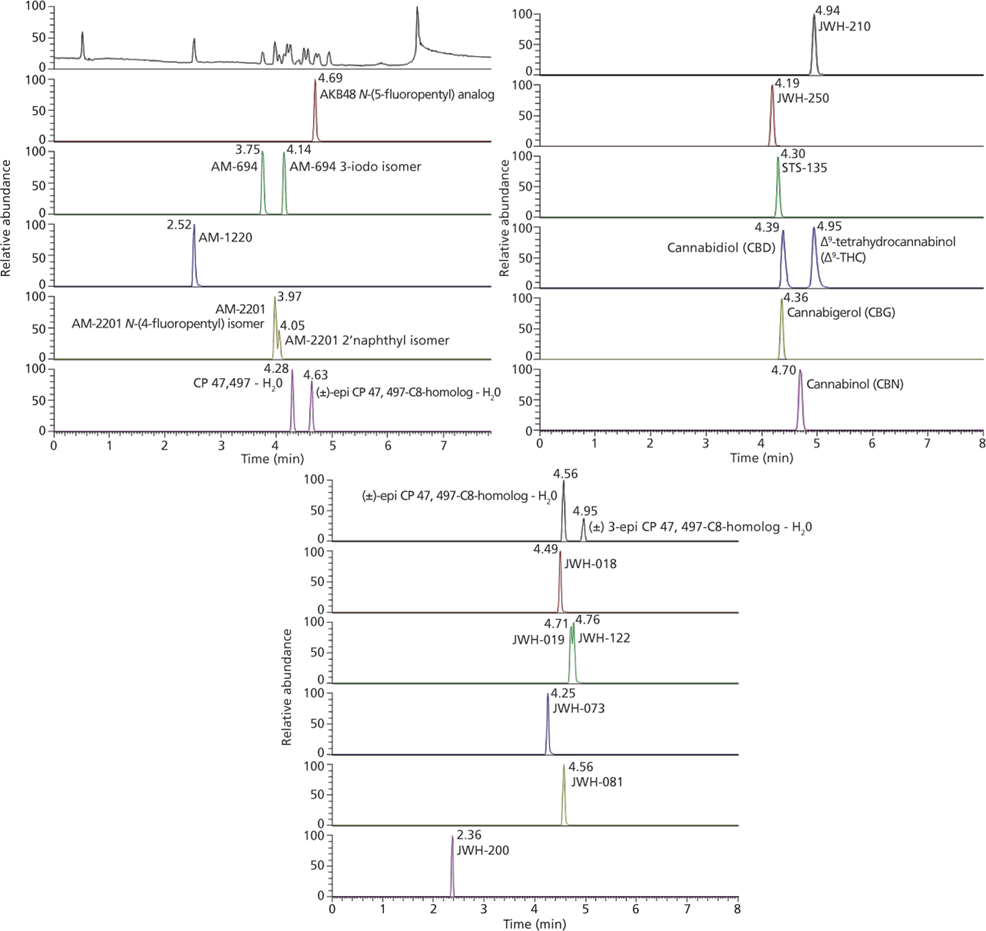
Figure 2: Typical chromatograms obtained by LC–MS-MS in positive electrospray mode for a mixture containing all 24 analytes. The upper trace of the first panel represents the total ion chromatogram (TIC), followed by the extracted ion chromatograms of all the compounds spread over three panels for ease of presentation (parent ions shown).
When operating the orbital ion trap MS system at a resolution of 30,000, approximately 1.5 scans (points) per second were obtained for the mixture, containing 24 standards analyzed simultaneously. This acquisition scan speed was well suited for the narrow peaks (5–8 s wide) produced by the core–shell particle chromatography and allowed a very reliable quantification and improved method sensitivity. The well selected parent-fragment transitions helped to enhance the method selectivity. As seen in Figure 2 (spread across 3 panels for ease of peak identification), it was possible to positively identify 24 cannabinoids by differentiating them with a combination of accurate mass, retention time, and fragmentation pattern (MS2). For example, AM-2201 and AM-2201 N-(4-fluoropentyl) have the same accurate mass and retention time and very similar fragmentation patterns, as shown in Figure 3. However, a signal at m/z 340, generated by the loss of fluorine from a secondary carbon, is only present in the MS2 of AM-2201 N-(4-fluoropentyl) and allows distinction between the two. Similarly, JWH-019 and JWH-122 are eluted within 0.05 min of each other and have the same accurate mass. Without reinjecting, they could be identified by their completely different MS2 fragmentation patterns (Figure 4). The MS3 data were acquired but not actually needed for the screening method. In the eventuality of samples with a new analog of identical parent ion mass, retention time, and MS2, the MS3 data are available for identification.
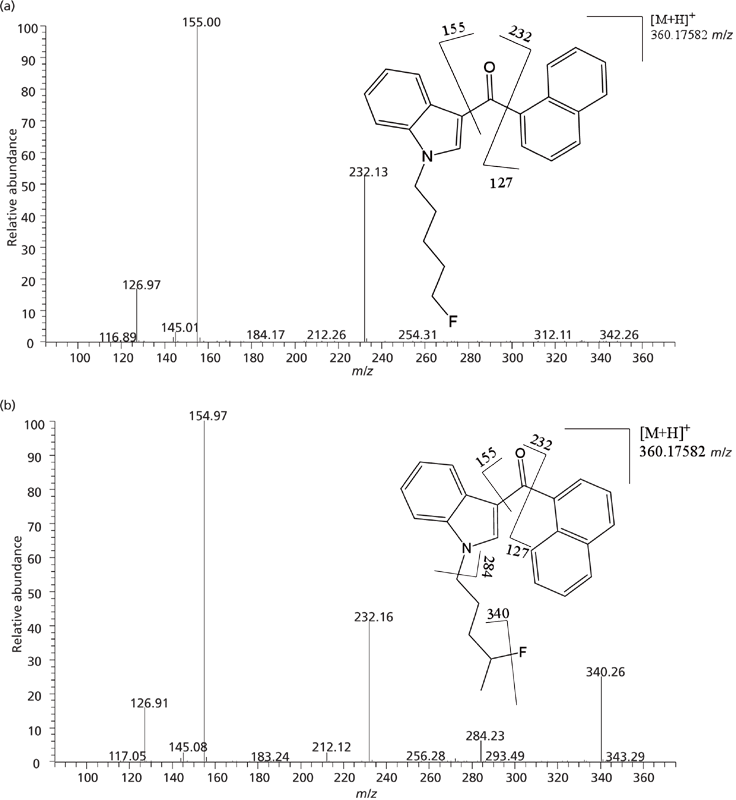
Figure 3: Fragmentation pattern of two isomers: (a) AM-2201 and (b) AM-2201 N-(4-fluoropentyl) isomer.
Figure 2 shows all compounds eluted between 2.36 and 4.94 min. Adulterated natural remedies can contain new synthetic drug substances of unknown polarity. It is therefore necessary to use caution when developing fast chromatographic separations; if additional yet-to-be characterized synthetic cannabinoids are present, excessive coelution could compromise their postacquisition identification using the untargeted full scan event in the acquisition method.
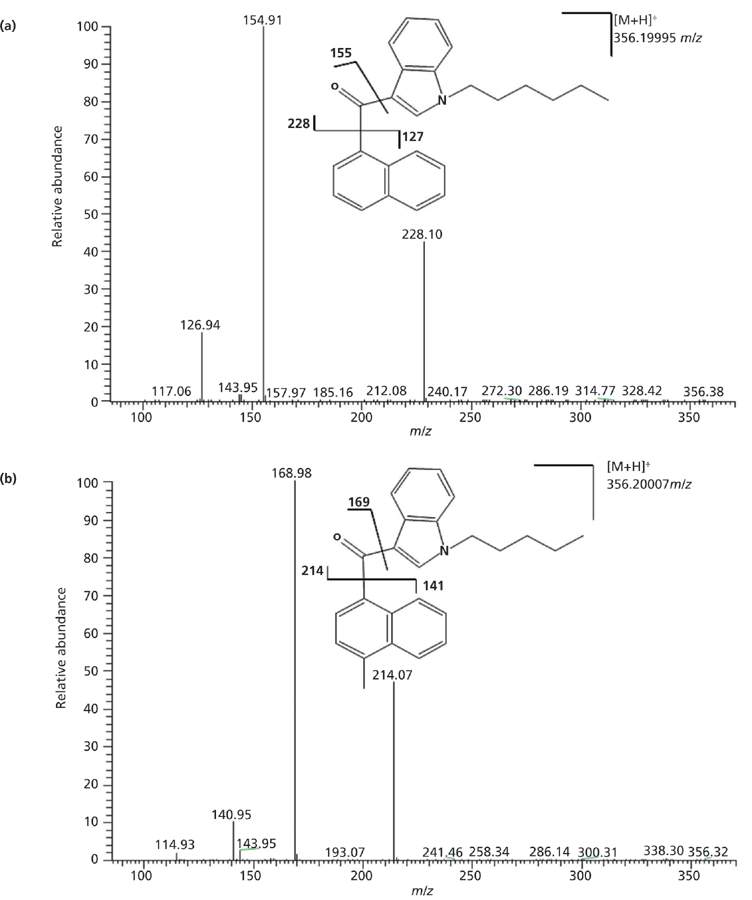
Figure 4: Fragmentation pattern of two isomers: (a) JWH-019 and (b) JWH-122.
Matrix effects were evaluated in four samples (tablet and herbal based) spiked with the 24 analytes before extraction. A comparison of the chromatograms to that of the standard mixture revealed no difference in peak areas for the 24 analytes. To evaluate carryover, blanks injected after samples were used. No carryover was detected at analyte concentrations below 50 ng/mL whereas most compounds presented 0.1–0.3% carryover at 250 ng/mL and 0.4–1.0% at 1000 ng/mL. Therefore, we suggest that two blank injections be used between samples at high concentrations. The linearity of 15 compounds, selected to be representative of the 24, spiked into an herbal matrix, was evaluated across a concentration range of 0.01–1000 ng/mL (n = 21). Linear regression was applied by plotting the peak area responses of each compound as a function of its respective concentration and applying a 1/x weighting factor. Calibration curve correlation coefficients (r2) ranged between 0.996 and 0.999. Detection limits (calculated at signal-to-noise ratio of 3) were between 0.03 ng/mL and 0.61 ng/mL for all but one compound regardless of the presence of matrix; the limit of detection (LOD) for (±) 3-epi-CP 47,497-C8-homolog was 1.52 ng/mL.
It was important to develop a simple and economical extraction method that was also fast and effective with good recovery to complement the rapid LC–MS-MS separation. For 12 cannabinoids, selected to be representative of the 24, recoveries ranged between 92–110% across three concentrations (50, 250, and 1000 ng/mL).
The precision and accuracy of the method were evaluated for 10 representative compounds at 50, 250, and 1000 ng/mL. Each concentration level was prepared in five replicates by spiking the appropriate amount of analyte standard into a matrix (tablet or herbal based) and each sample was injected five times. Intra-assay precision ranged from 1.2–4.0% relative standard deviation (RSD) across the three concentration levels. The procedure was repeated the following week to determine the interassay precision, which ranged from 2.9% to 9.7% RSD. Even though only 10 compounds were spiked for method validation, all 24 were injected numerous times individually, and together, during the method development with no significant changes (that is, within repeatability error) in peak areas and retention times. For example, after 25 injections of standard AM-694 (five replicates for each of the five different samples), essentially no change in retention time (0.09% RSD intra-assay and interassay) and only a very small change in peak area (1.7% RSD) was observed. The same results were obtained for the other compounds (data not shown). The method accuracy, determined by comparing the calculated concentration with the true value spiked into the matrix was within 10% for all 10 compounds at all concentrations tested.
Application to the Analysis of Seized Samples
We used the rapid LC–MS-MS screening method to analyze 11 seized samples (four incense sticks, two cigarettes, three herbal samples, one cannabis sample, and one tablet), all from nonregistered sources. Seven were found to be positive for cannabinoids. In one of the incense sticks, two synthetic cannabinoids were detected: JWH-018 at 4.48 min and JWH-073 at 4.24 min, as shown in Figure 5. These two synthetic analogs are controlled substances and, as highlighted in the introduction, their presence in these products is illegal. The incense sticks were therefore designated for withdrawal from distribution.

Figure 5: Illegal product (incense stick) showing the presence of controlled synthetic cannabinoids: JWH-018 and JWH-073. The uppermost panel represents the TIC and the lower two extracted chromatograms showing detection of JWH-018 (middle panel) and JWH-073 (lower panel).
In the chromatographic separation of the cannabis plant sample (Figure 6), a number of endogenous cannabinoids were detected. THC, the main psychoactive compound, was eluted at 4.93 min. Cannabigerol was detected at 4.36 min, and unlike THC, it does not mimic psychosis symptoms even though it interacts with the CB2 receptor in the brain (1). Cannabidiol, identified at 4.48 min, is another natural cannabinoid that is highly abundant in cannabis, up to 40% in the plant extract; however, it is not psychoactive. Cannabinol, which also interacts with the CB2 receptor, is usually present at low concentrations in fresh cannabis samples, but its abundance increases as it is formed by THC oxidative degradation by exposure to light or air (13). It was identified at 4.69 min with approximately a fivefold higher signal compared to THC (Figure 6), which suggests that the cannabis sample had undergone extensive oxidation.
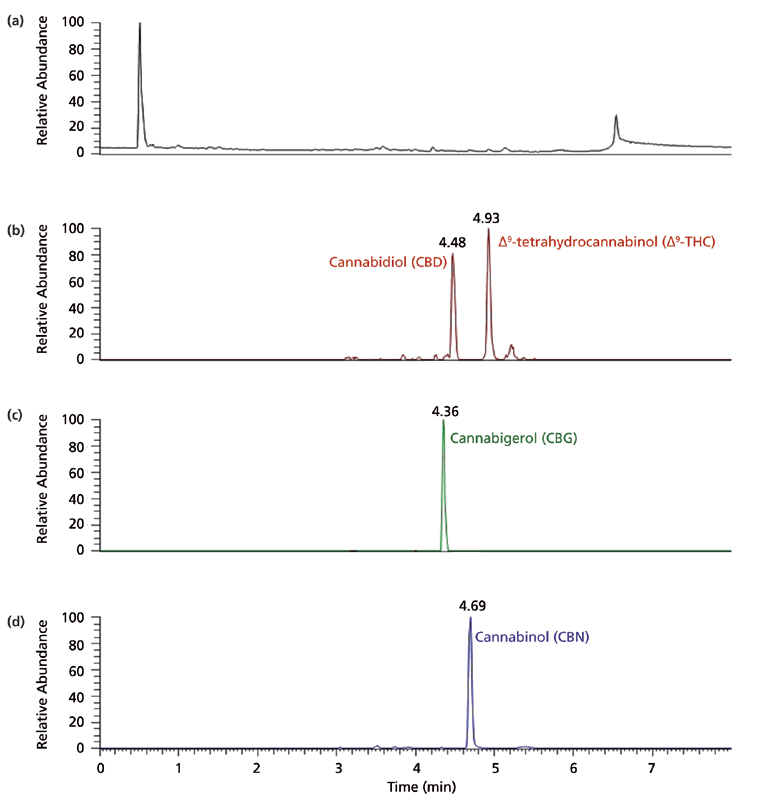
Figure 6: Cannabis sample showing the presence of THC, cannabidiol, cannabigerol, and cannabinol: (a) TIC, (b–d) extracted ion chromatograms showing the detection of the four cannabinoid compounds.
The cannabis plant sample was previously analyzed by validated thin-layer chromatography (TLC) and GC–MS methods in a local government laboratory. The other samples in this study were previously analyzed by two validated HPLC–photodiode array (PDA) detection and GC–MS routine methods from the same government laboratory. The results obtained with the current rapid LC–MS-MS approach were in perfect agreement with the routine methods in that there were no false positive or false negative results; however, the new approach was four times faster than the validated HPLC–PDA method, six times more rapid than the validated GC–MS method, and more sensitive than both methods. Most cannabinoid analysis methods screen for metabolites in biological samples (such as urine, blood, and hair) because the parent compounds are rapidly metabolized (11,15). For screening suspected adulterated herbal mixtures, identification of the parent drug is required. Several rapid LC–MS-MS methods for cannabinoid screening have been reported recently in which 15–20 parent compounds and, in some cases, over 20 metabolites, have been separated in times ranging from 8 to 20 min (12,14,16). The large majority of these are MRM-based approaches, which means they are targeted and thus monitor only analogs predefined in the method; they are entirely inefficient for detecting new-generation cannabinoid analogs.
Conclusion
The development of a rapid, selective, and sensitive LC–MS-MS screening method for simultaneous identification of 24 synthetic and natural cannabinoids present in herbal smoking mixtures, incense sticks, and tablet matrices has been described. The high mass-resolution power of an orbital ion trap mass spectrometer and its compatibility with the high peak efficiency provided by core–shell particle chromatography contributed to the excellent selectivity of the method. Additional confidence in analyte identification for the 24 compounds targeted was provided by the fragmentation patterns. The novelty of this work lies in the high-resolution full-scan event in the acquisition method that allows postanalysis identification, in an untargeted approach, of additional species in the complex matrices. This is highly relevant to the current application because of the emergence of new generations of cannabinoid analogs that try to be one step ahead of the controlled substances act. The need for such untargeted screening approaches is starting to be recognized by the analytical community as shown in recent reports by Scheidweiler and colleagues (15) and Shanks and colleagues (8). Our rapid LC–MS-MS screening method has the potential to be an indispensable forensic analysis tool for identifying illegal drug substances and adulterated products.
Philippe Lebel, Karen C. Waldron, and Alexandra Furtos are with the Department of Chemistry at the Université de Montréal, in Montréal, Canada. Direct correspondence to: Alexandra.furtos@umontreal.ca
References
(1) L. Console-Bram, J. Marcu, and M.E. Abood, Prog. Neuro-Psychopharmacol. Biol. Psychiatry38(1), 4–15 (2012).
(2) Understanding the 'Spice' phenomenon, Lisbon, 2009, http://www.emcdda.europa.eu/publications/thematic-papers/spice, consulted 09/22/ 2014.
(3) K.A. Seely, J. Lapoint, J.H. Moran, and L. Fattore, Prog. Neuro-Psychopharmacol. Biol. Psychiatry39(2), 234–243 (2012).
(4) Synthetic Drug Abuse Prevention Act of 2012, https://www.govtrack.us/congress/bills/112/s3190/text, consulted 09/22/2014.
(5) L.N. Sacco and K. Finklea, "Synthetic Drugs: Overview and Issues for Congress," 2014, https://www.hsdl.org/?view&did=757033, consulted 09/22/2014.
(6) S. Dresen, N. Ferreirós, M. Pütz, F. Westphal, R. Zimmermann, and V. Auwärter, J. Mass Spectrom.45(10), 1186–1194 (2010).
(7) A.D. de Jager, J.V. Warner, M. Henman, W. Ferguson, and A. Hall, J. Chromatogr. B: Anal. Technol. Biomed. Life Sci.897, 22–31 (2012).
(8) K.G. Shanks, G.S. Behonick, T. Dahn, and A. Terrell, J. Anal. Toxicol.37(8), 517–525 (2013).
(9) N. Uchiyama, M. Kawamura, R. Kikura-Hanajiri, and Y. Goda, Forensic Sci. Int. 227(1–3), 21–32 (2013).
(10) T. Sobolevsky, I. Prasolov, and G. Rodchenkov, Forensic Sci. Int.200(1–3), 141–147 (2010).
(11) A. Grigoryev, S. Saychuk, A. Melnik, N. Moskaleva, J. Dzhurko, M. Ershov, A. Nosyrev, A. Vedenin, B. Izotov, I. Zabirova, and V. Rozhanets, J. Chromatogr. B: Anal. Technol. Biomed.Life Sci.879(15–16), 1126–1136 (2011).
(12) K.B. Scheidweiler and M.A. Huestis, J. Chromatogr. A1327(0), 105–117 (2014).
(13) A.A.M. Stolker, J. van Schoonhoven, A.J. de Vries, I. Bobeldijk-Pastorova, W.H.J. Vaes, and R. van den Berg, J. Chromatogr. A1058(1–2), 143–151 (2004).
(14) S. Kneisel, M. Speck, B. Moosmann, T.M. Corneillie, N.G. Butlin, and V. Auwarter, Anal. Bioanal. Chem.405(14), 4691–4706 (2013).
(15) K. Scheidweiler, M.Y. Jarvis, and M. Huestis, Anal. Bioanal. Chem. Published on-line: September 16, 2014, 1–15 (2014).
(16) J.P. Danaceau, E.E. Chambers, and K.J. Fountain, "Analysis of Synthetic Cannabinoids from Urine for Forensic Toxicology using Oasis HLB μElution plates and CORTECS UPLC Columns," Waters Corporation, 2013, http://www.waters.com/waters/library.htm?lid=134763848&lset=1&locale=en_CA, consulted 09/22/2014.
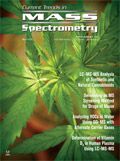
Rapid, Portable Mid-Infrared Spectroscopy Identifies Aflatoxins in Peanuts
March 10th 2025Researchers have developed a portable mid-infrared (IR) spectroscopic method combined with chemometric analysis to rapidly and non-destructively detect aflatoxin contamination in Aspergillus-infected peanuts. This approach offers a field-deployable alternative to traditional wet chemistry methods, with high sensitivity and specificity in identifying toxic metabolites such as aflatoxins.
More Than Just Acronyms at EAS 2023
November 14th 2023Award recipient John McLean of Vanderbilt University said hybrid techniques do not exist purely as combinations of letters, slashes, and hyphens—they have been built on the shoulders of decades’ worth of analysis intended to refine and simplify workflow.
A Look at Rapid Quantification of PFAS in Non-Potable Waters
March 1st 2020The presence of per- and polyfluoralkyl substances (PFAS) in water is an important health and environmental concern. Liquid chromatography–mass spectrometry (LC–MS) has been established as the most suitable technology for monitoring these substances. A method is described, using EPA 8327, for PFAS analysis in groundwater, surface water, and wastewater.
Determination of Very Low Abundance Diagnostic Proteins in Serum Using Immunocapture LC–MS/MS
July 1st 2017There is growing interest in the determination of endogenous proteins in biological samples for diagnostic purposes, because a concentration increase or decrease of such proteins can allows us to monitor the state of a pathological condition such as cancer. Immunocapture LC–MS/MS analysis combines the workflow of conventional immunological assays with LC–MS analysis. This article describes typical challenges, such as cross reactivity and the mass spectrometer’s dynamic range, as well as the advantages of isoform differentiation and multiplexing.